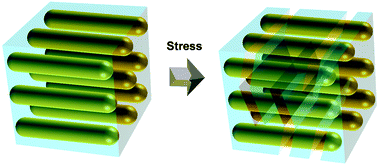Intelligent and highly sensitive strain sensor based on indium tin oxide micromesh with a high crack density†
Abstract
Cracks play an important role in strain sensors. However, a systematic analysis of how cracks influence the strain sensors has not been proposed. In this work, an intelligent and highly sensitive strain sensor based on indium tin oxide (ITO)/polyurethane (PU) micromesh is realized. The micromesh has good skin compatibility, water vapor permeability, and stability. Due to the color of the ITO/PU micromesh, it can be invisible on the skin. Based on the fragility of ITO, the density and resistance of cracks in the micromesh are greatly improved. Therefore, the ITO/PU micromesh strain sensor (IMSS) has an ultrahigh gauge factor (744.3). In addition, a finite element model based on four resistance layers is proposed to explain the performance of the IMSS and show the importance of high-density cracks. Compared with other strain sensors based on low-density cracks, the IMSS based on high-density cracks has larger sensitivity and better linearity. Physiological signals, such as respiration, pulse, and joint motion, can be monitored using the IMSS self-fixed on the skin. Finally, an invisible and artificial throat has been realized by combining the IMSS with a convolutional neural network algorithm. The artificial throat can translate the throat vibrations of the tester automatically with an accuracy of 86.5%. This work has great potential in health care and language function reconstruction.



 Please wait while we load your content...
Please wait while we load your content...